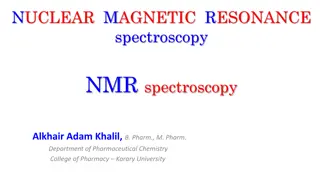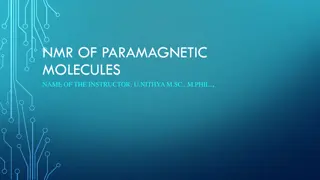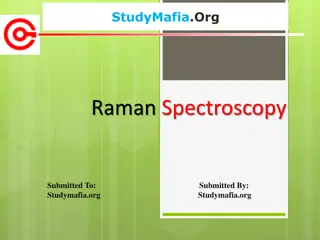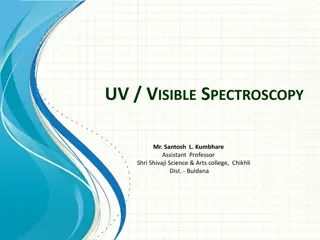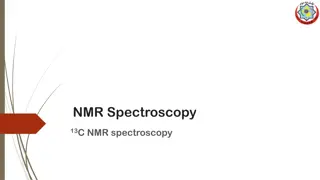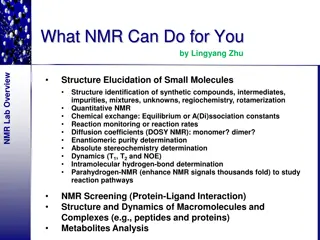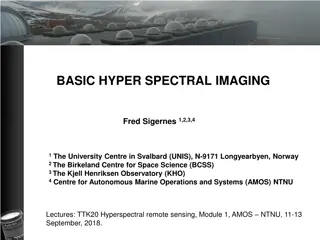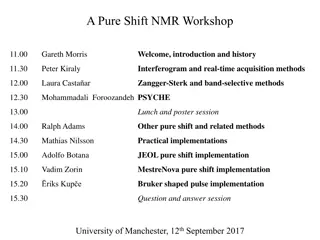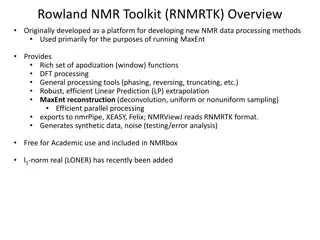NMR Spectroscopy in Pharmaceutical Analysis
Introduction to acquiring a 1H NMR spectrum in pharmaceutical analysis, including the role of magnetic fields, use of superconducting materials, and the principles behind NMR spectrometers.
Download Presentation

Please find below an Image/Link to download the presentation.
The content on the website is provided AS IS for your information and personal use only. It may not be sold, licensed, or shared on other websites without obtaining consent from the author.If you encounter any issues during the download, it is possible that the publisher has removed the file from their server.
You are allowed to download the files provided on this website for personal or commercial use, subject to the condition that they are used lawfully. All files are the property of their respective owners.
The content on the website is provided AS IS for your information and personal use only. It may not be sold, licensed, or shared on other websites without obtaining consent from the author.
E N D
Presentation Transcript
Advanced Pharmaceutical Analysis Introduction to Spectroscopy Dr. Mohammed Al Amiedy
Acquiring a 1H NMR Spectrum NMR spectroscopy requires a strong magnetic field as well as a source of rf radiation. The magnetic field establishes an energy gap ( E) between spin states, which enables the nuclei to absorb rf radiation. The magnitude of this energy gap depends on the strength of the imposed external magnetic field. The energy gap increases with increasing magnetic field strength. The strength of the magnetic field determines the range of frequencies that must be used.
Acquiring a 1H NMR Spectrum The strong magnetic fields employed in NMR spectroscopy are produced by passing a current of electrons through a loop composed of superconducting materials. These materials offer virtually zero resistance to the electric current, allowing for large magnetic fields to be produced. The superconducting materials only maintain their properties at extremely low temperatures (just a few degrees above absolute zero) and must therefore be kept in a very low temperature container. This extremely cold environment enables the use of superconductors that generate the large magnetic fields required in NMR spectroscopy.
Acquiring a 1H NMR Spectrum An NMR spectrum could be obtained by holding the magnetic field constant and slowly sweeping through a range of rf frequencies, monitoring which frequencies were absorbed. The first generation of NMR spectrometers, called continuous-wave (CW) spectrometers, produced the same result by holding the frequency of rf radiation constant and slowly increasing the magnetic field strength, while monitoring which field strengths produced a signal. CW spectrometers are rarely used anymore, as they have been replaced by pulsed Fourier-transform NMR (FT-NMR).
NMR Spectrometer In an FT-NMR spectrometer, the magnetic field is held constant and the sample is irradiated with a short pulse that covers the entire range of relevant rf frequencies. All protons are excited simultaneously and then begin to relax to their original spin states. As each type of proton relaxes, it releases energy in a particular way, generating an electrical impulse in a receiver coil. The receiver coil records a complex signal, called a free induction decay (FID), which is a combination of all of the electrical impulses generated by each type of proton.
NMR Spectrometer The FID is then converted into a spectrum via a mathematical technique called a Fourier transform. Since each FID is acquired in 1 2 seconds, it is possible to acquire hundreds of FIDs in just a few minutes, and the FIDs can be averaged.
Preparing the sample In order to acquire a 1H NMR spectrum of a compound, the compound is usually dissolved in a solvent and placed in a narrow glass tube, which is then inserted into the NMR spectrometer. If the solvent itself has protons, the spectrum will be confused with signals from the solvent, rendering it unreadable. As a result, solvents without protons must be used. Although there are several solvents that lack protons, such as CCl4, these solvents do not dissolve all compounds.
Characteristics of a 1H NMR Spectrum The spectrum produced by 1H NMR spectroscopy is generally rich with information that can be interpreted to determine a molecular structure. The first valuable piece of information is the number of signals. This spectrum appears to have three different signals. Each signal has three important characteristics: The location of each signal indicates the electronic environment of the protons giving rise to the signal. The area under each signal indicates the number of protons giving rise to the signal.
Characteristics of a 1H NMR Spectrum The shape of the signal indicates the number of neighbouring protons.
Number of Signals The number of signals in a 1H NMR spectrum indicates the number of different kinds of protons (protons in different electronic environments). Protons that occupy identical electronic environments are called chemically equivalent, and they will produce only one signal. Two protons are chemically equivalent if they can be interchanged via a symmetry operation, either rotation or reflection.
Number of Signals Consider the two protons on the middle carbon of propane. Imagine that this molecule is rotated 180 about the following axis while your eyes are closed
Number of Signals When you open your eyes, you cannot determine whether the molecule was rotated or not. From your point of view, the molecule appears exactly as it did before rotation, and it therefore has an axis of symmetry. The two protons on the middle carbon of propane are interchangeable by rotational symmetry and are therefore said to be homotopic. Homotopic protons are chemically equivalent.
Number of Signals In each of these examples, the two identified protons are homotopic, because they can be interchanged by rotational symmetry. If you are having trouble seeing axes of symmetry, there is a simple method, called the replacement test, that will allow you to verify whether or not two protons are homotopic. Draw the compound two times, each time replacing one of the protons with deuterium
Number of Signals Then, determine the relationship between the two drawings. If they represent the same compound, then the protons are homotopic. Now consider the two protons on the alpha carbon of ethanol and imagine that this molecule is rotated 180 while your eyes are closed.
Number of Signals When you open your eyes, you will be able to determine that the molecule has been rotated. The OH group is now on the left side. The two protons on the alpha carbon of ethanol are not interchangeable by rotational symmetry. These protons are therefore not homotopic. They can be interchanged by reflectional symmetry. Imagine that the molecule is reflected about the plane of the page while your eyes are closed.
Number of Signals When you open your eyes, you cannot determine whether the molecule was reflected or not. The molecule appears exactly as it did before reflection. In this case, there is a plane of symmetry, and the protons are said to be enantiotopic. In the achiral environment of an NMR experiment, enantiotopic protons are chemically equivalent, because they are interchangeable by reflectional symmetry.
Number of Signals In these examples the two highlighted protons are enantiotopic because they are interchangeable by reflectional symmetry. If you are having trouble seeing planes of symmetry, you can resort once again to the replacement test. Simply draw the compound twice, each time replacing one of the protons with deuterium. Then determine ]he relationship between the two drawings. If they are enantiomers, then the protons are enantiotopic.
Number of Signals When determining the relationship between two protons, always look for rotational symmetry first. The figure below indicates how to determine the relationship between two protons. First determine if there is an axis of symmetry that interchanges the protons. If there is, then the protons are homotopic, whether or not there is a plane of symmetry. If the protons cannot be interchanged by rotation, then look for reflectional symmetry. If there is a plane of symmetry, then the protons are enantiotopic.
Number of Signals If two protons are neither homotopic nor enantiotopic, then they are not chemically equivalent. As an example, consider the protons on C3 of (R)-2-butanol. These protons cannot be interchanged by either rotational symmetry or reflectional symmetry. Therefore, these two protons are not chemically equivalent. In this case, the replacement test produces diastereomers.


